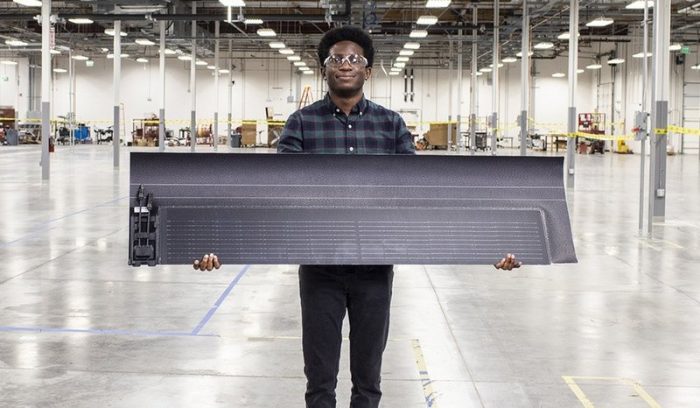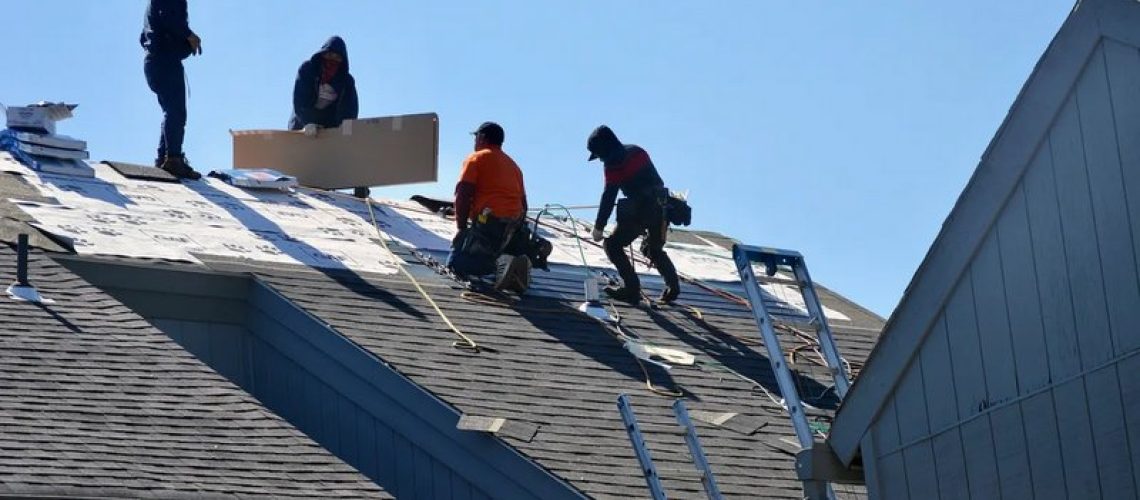Via Energy News Now: If Jonathan Lockwood had to spring for a new roof, he was determined to find a versatile cover that could go beyond just keeping his 1981 townhome dry. He also wanted to slash his escalating electric bill.
Aware that greenlighting traditional rooftop solar panels would be a tough slog in his hyper-regulated planned community in Northern Virginia, he opted for a lower-profile product that integrates solar technology into nailable asphalt shingles.
“If you’re going to reroof, you might as well put on this added benefit,” said Lockwood, while watching a proficient crew methodically install a sleek 3.86-kilowatt system atop his end unit in late March.
“And see how flat it is?” the 67-year-old asked. “It doesn’t look like a contraption from a Mars colony.”
That’s an apt description of what manufacturer GAF Energy launched last year as the Timberline Solar Energy Shingle roof. The company recently branched into Virginia, drawn by the state’s potential to be a pacesetter with residential sun power.
Lockwood’s two-story Fairfax County home adjacent to a pond is one of about 100 in Reston’s Wharf Cluster, modeled after a New England fishing village.
As the first on his “block” to go solar, he and his wife, Kathleen, expect to be the envy of their neighbors when their triple-digit utility bills drop by as much as half, or $74 monthly, via a net-metering arrangement with Dominion Energy.
Jim Hester, an account executive with a Virginia branch of Homefix Custom Remodeling, lined Lockwood up with his new roof. Homefix, a longtime GAF partner, was selected as part of a pilot program when GAF Energy debuted Timberline on a limited basis.
Even though Homefix has a sister company that installs rack-mounted arrays, Hester leaned away from that option this time.
Why? One, he knew traditional panels would be a bear to install in a house with a loft, cathedral ceilings, and no attic to hide protruding infrastructure. And two, he feared tangling with notoriously strict homeowner associations.
“The HOAs can be brutal in Reston,” Hester said, recalling encounters on separate home improvement projects. “If you put in the wrong color mailbox, they practically want to put you in jail.
“But we had no blowback with the Timberline roof,” he said about dealing initially with the association affiliated with the Wharf Cluster and then the organization overseeing the whole town. “They just wanted us to dot our I’s and cross our T’s.”
Aesthetics matter when neighbors are so close, Hester said. It’s a bonus, he noted, that the two-in-one solar shingles relieve homeowners from handling pairs of contractors and warranties.

Panels might be a better fit if a roof is in good repair, he emphasized, but solar shingles are a “no-brainer” for a house with an old leaky lid.
Generally, a homeowner can expect a Timberline roof to be on par with the cost of a traditional shingle roof with bolt-on solar panels, according to a GAF Energy spokesperson. Prices vary because they are set by the roofing partner contractor.
“These systems aren’t for everybody and they’re not cheap,” Hester said. “But in my personal opinion, they’re going to take over the solar world.”
Wait, didn’t Tesla already do this?
Those who recall Tesla’s acquisition of SolarCity seven years ago might figure Elon Musk’s company had already cornered the market on solar shingles. But that hasn’t evolved as proposed.
Homefix CEO Adam Shampaine said it’s a common misperception among the public that the shingles produced by GAF Energy and Tesla are identical.
“The Tesla shingle wasn’t a shingle. It was thousands of little panels covering your roof,” he said. “It was so complicated that it took two weeks to install and needed specially trained people. It was cost-prohibitive and didn’t function very well.”
Those setbacks motivated GAF Energy to introduce a simpler system.
As was the case with Lockwood’s home, a trained roofing crew contracted by Homefix installs the solar shingles in one day. GAF Energy then sweeps in behind to add the inverter and other components, and complete the electrical hookup.
Rey Holmes, vice president of product at GAF Energy, joined the San Jose-based company in 2019 after stints in the engineering departments at both SolarCity and then Tesla. Holmes praised Musk’s roofing initiative as “pioneering.” However, the combination of an intricate product and a specialized labor force stymied its ability to expand at scale.
“It has taken roof-integrated solar 12 to 13 years to eliminate those bottlenecks because up until now it has always been solar companies trying to make roofing,” Holmes explained. “Here, it’s a roofing company making solar.”
GAF, which is GAF Energy’s sister business, is North America’s largest roofing and waterproofing manufacturer. It is connected to 8,500 certified contractors nationwide, including 400 in Virginia.
Homefix is one of the 15 contractors approved to offer homeowners throughout Virginia a Timberline roof.
“Yes, we’ll have competitors in the long term,” Holmes said. “But we don’t have competitors now.”
Virginia is one of 16 states where U.S.-manufactured Timberline shingles are available.
“We go where we already have a strong contractor network and a strong presence via GAF,” he said, adding that Maryland, Virginia and the District of Columbia are “an area of massive possibility.”
“That dual value is huge,” Holmes said. “We’re offering a different category of product. We have an ability to go places where other solar companies cannot and leverage roofing companies to be that trusted labor force.”
Competitor welcomes shingles to solar table
While some solar companies might cast aspersions at a competing product, Herve Billiet of Fairfax County isn’t in that category. In fact, the CEO and co-founder of Ipsun Solar has adopted a more-the-merrier philosophy.
Billiet applauds GAF Energy, part of giant Standard Industries, for beginning to fill a gap in building-integrated photovoltaics when other companies have fallen short.
“I see this as a massive improvement,” he said. “We need more investments like this and all the innovation we can get.”
Even if his crews worked 24/7, Ipsun couldn’t possibly cover every Virginia rooftop.
“I can’t do this myself,” said Billiet, whose projects have generated more than 100 million kilowatt-hours of clean energy thus far. “The more people we have who are getting power from a clean, renewable source, the better off we are.”
The master electrician and renewable energy veteran said he started Ipsun because of the urgency to address climate change.
An array of panels will be the right solution for some, while shingles could be the correct match for a homeowner with an aged-out roof. Whichever route is pursued, Billiet recommended that customers gather several quotes and then figure out the financially sensible solution to their individual situation.
Even though Billiet is partial to panels, he anticipates shingles will continue to gain capacity and market share in his territory in and around the nation’s capital.
“If that technology surpasses us, we as the solar industry will have to adapt and all become roofers,” he speculated with a laugh. “I’m open to using whatever technology is available to me.”
For Lockwood, turning to the sun hinged on economics. He plans on reaping the added value of his new roof because he and his wife are content to stay put in the home they purchased in 2005.
Homefix and GAF Energy couldn’t provide specific numbers, but a just-released U.S. study revealed that traditional solar panels can boost the sale price of a home by roughly 4%. The amount varied depending on geographic location.
SunPower, a solar developer incorporated in Silicon Valley in 1985, released the March report drawing upon data from Zillow and EcoWatch.
While Lockwood admitted to admiring Greta Thunberg, the young Swedish climate activist, he emphasized that “I’m not a virtue-signaling environmentalist.”
“I’m doing this for practical-person reasons,” he said about his solar switch. “That includes a higher appraisal and savings on my power bill.
“What made it an even bigger sell is the federal government practically paying people to go solar.”
The reroofing of his house and adjacent garage — a total of 2,042 square feet — qualifies him for a 30% federal tax credit. Lockwood added that it’s a relief that the warranty on photovoltaics lasts 25 years and is double that for the asphalt shingles.
“They really put their money where their mouth is,” Hester said about GAF Energy.
He explained that Lockwood’s warranty guarantees his array will meet certain production standards during its lifespan. For instance, the company will reimburse him if it underperforms on producing a promised 6,519 kWh in its first year.
In addition, Lockwood has access to his system’s solar renewable energy credits. Briefly, one credit is created for each 1,000 kWh of electricity his system produces. In Virginia, each one is currently worth $52.
As Lockwood watched the roofers toil away on March 30, neighbors Neal and Pat Gause wandered over to gander at the high-up novelty. They were impressed it could simultaneously save their friend money while being bland and conforming enough to glide over the usual hurdles of a picky design review board.
The Gauses aren’t keen on following his lead immediately because their roof is shipshape and they spend half the year in Hawaii. But then again, they agreed that solar shingles could be a rational investment, especially if Lockwood provides uplifting updates.
He’s eager to start calculating results once his home is outfitted with the electrical infrastructure this month and he goes live with Dominion.
“I guess we’re the role model on the block for solar,” Lockwood concluded. “A lot of people are curious about how this will work out. We’ll see what happens.”
Elizabeth McGowan is a longtime energy and environment reporter who has worked for InsideClimate News, Energy Intelligence and Crain Communications. Her groundbreaking dispatches for InsideClimate News from Kalamazoo, Michigan, “The Dilbit Disaster: Inside the Biggest Oil Spill You Never Heard Of” won a Pulitzer Prize for National Reporting in 2013. Her book, “Outpedaling ‘The Big C’: My Healing Cycle Across America” is available from Bancroft Press. Based in Washington, D.C., Elizabeth covers the state of Virginia.
Tags: GAF Energy



